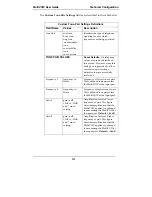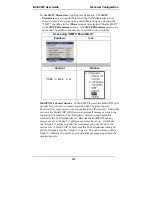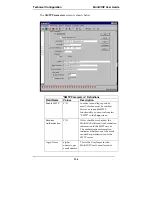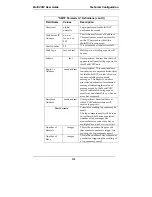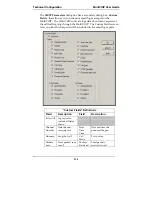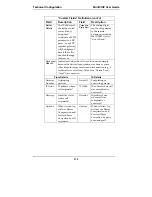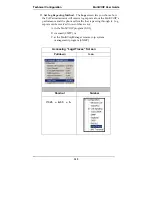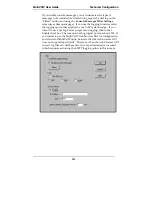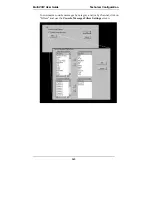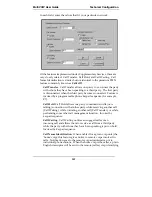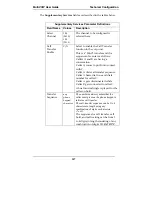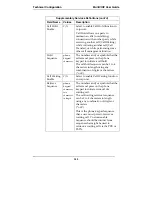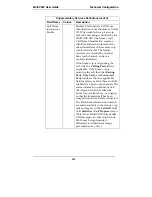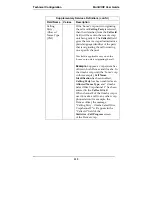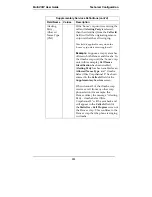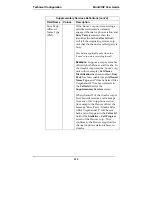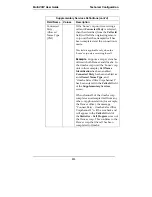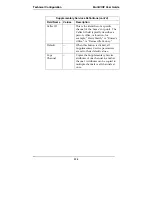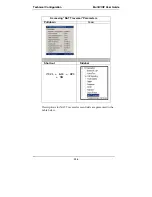
MultiVOIP User Guide
Technical Configuration
145
In each field, enter the values that fit your particular network.
Of the features implemented under Supplementary Services, three are
very closely related: Call Transfer, Call Hold, and Call Waiting. Call
Name Identification is similar but not identical to the premium PSTN
feature commonly known as
Caller ID
.
Call Transfer
. Call Transfer allows one party to re-connect the party
with whom they have been speaking to a third party. The first party
is disconnected when the third party becomes connected. Feature is
invoked by a programmable phone keypad sequence (for example,
#7).
Call Hold
. Call Hold allows one party to maintain an idle (non-
talking) connection with another party while receiving another call
(Call Waiting), while initiating another call (Call Transfer), or while
performing some other call management function. Invoked by
keypad sequence.
Call Waiting
. Call Waiting notifies an engaged caller of an
incoming call and allows them to receive a call from a third party
while the party with whom they have been speaking is put on hold.
Invoked by keypad sequence.
Call Name Identification
. When enabled for a given voip unit (the
‘home’ voip), this feature gives notice to remote voips involved in
calls. Notification goes to the remote voip administrator, not to
individual phone stations. When the home voip is the caller, a plain
English descriptor will be sent to the remote (callee) voip identifying
Summary of Contents for MULTIVOIP MVP-3010
Page 6: ...6 Chapter 1 Overview ...
Page 28: ...28 Chapter 2 Quick Start Instructions ...
Page 38: ...Technical Configuration T1 E1 MultiVOIP User Guide 38 Chapter 4 Software Installation ...
Page 49: ...49 Chapter 5 Technical Configuration ...
Page 58: ...Technical Configuration MultiVOIP User Guide 58 Config Info CheckList ...
Page 117: ...MultiVOIP User Guide Technical Configuration 117 ...
Page 139: ...MultiVOIP User Guide Technical Configuration 139 ...
Page 170: ...170 Chapter 6 T1 Phonebook Configuration North American Telephony Standards ...
Page 184: ...T1 Phonebook Configuration MultiVOIP User Guide 184 3 Select Inbound PhoneBook List Entries ...
Page 208: ...208 Chapter 7 E1 Phonebook Configuration European Telephony Standards ...
Page 252: ...252 Chapter 8 Operation and Maintenance ...
Page 257: ...MultiVOIP User Guide Operation Maintenance 257 The Call Progress Details Screen ...
Page 265: ...MultiVOIP User Guide Operation Maintenance 265 The Logs Screen ...
Page 277: ...MultiVOIP User Guide Operation Maintenance 277 ...
Page 280: ...Operation and Maintenance MultiVOIP User Guide 280 T1 Statistics Screen ...
Page 288: ...Operation and Maintenance MultiVOIP User Guide 288 ...
Page 343: ...343 Chapter 9 Warranty Service and Tech Support ...
Page 347: ...347 Chapter 10 Regulatory Information ...
Page 352: ...352 Appendix A Cable Pinouts ...
Page 358: ...358 Appendix B TCP UDP Port Assignments ...
Page 360: ...360 Appendix C Installation Instructions for MVP428 Upgrade Card ...
Page 365: ...MultiVOIP User Guide Index 365 Index ...
Page 395: ...395 S000384A ...

